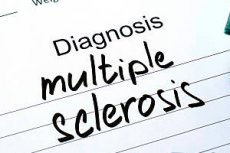Silent progression means a "fundamental turning point" in the understanding of multiple sclerosis
Sist anmeldt: 14.06.2024

Alt iLive-innhold blir gjennomgått med medisin eller faktisk kontrollert for å sikre så mye faktuell nøyaktighet som mulig.
Vi har strenge retningslinjer for innkjøp og kun kobling til anerkjente medieområder, akademiske forskningsinstitusjoner og, når det er mulig, medisinsk peer-evaluerte studier. Merk at tallene i parenteser ([1], [2], etc.) er klikkbare koblinger til disse studiene.
Hvis du føler at noe av innholdet vårt er unøyaktig, utdatert eller ellers tvilsomt, velg det og trykk Ctrl + Enter.

Progression of disability independent of relapse (PIRA), sometimes called “silent progression,” has become a key integrative concept in modern thinking of multiple sclerosis (MS).
"The observation that progression can occur without previous relapses in the early stages of relapsing-remitting multiple sclerosis (RRMS) has now been confirmed in several cohort studies and is recognized as the most common cause progression in relapsing patients," said Bruce Cree, MD, PhD, MAS, of the University of California, San Francisco (UCSF). "This observation represents a fundamental change in our understanding of MS."
Silent progression
In 2019, Cree and colleagues proposed the term “silent progression” to describe the accumulation of disability unrelated to inflammatory activity in MS, based on data from a prospective cohort UCSF EPIC.
The team studied patients with relapsing MS with long-term follow-up and found that relapses were associated with a temporary increase in disability at 1 year (P=0.012) but not with confirmed progression of disability (P=0.551).
In addition, relative brain volume decreased more rapidly in patients with progressive disability compared with patients whose disability remained stable.
The high effectiveness of MS therapy against clinical attacks made it possible to evaluate long-term results when elements of the focal disease were suppressed, the researchers noted. This opened the door to a fundamental change in thinking.
“Worsening disability early in the disease was previously thought to be due to relapses and was only later thought to be hidden after significant accumulation of disability,” Cree noted.
"This two-stage model is wrong," he stressed. "What we call secondary progressive MS is very likely the same process that occurs when relapsing activity is suppressed by highly effective anti-inflammatory drugs."
“In other words, secondary progressive MS is not secondary—progressive worsening of disability occurs in parallel with relapsing activity and can be detected early in the disease,” Cree said.
PIRA Definition
In 2023, researchers led by Ludwig Kappos, MD, of the University of Basel in Switzerland, proposed a harmonized definition of PIRA for general use based on a systematic review of the literature on PIRA.
“The first descriptions of PIRA have been followed by many studies in different patient groups to better understand this new phenomenon,” said co-author Jannis Müller, MD, also of the University of Basel.
"However, there was no uniform definition of PIRA, making comparison and interpretation of studies difficult," he continued. "We aimed to summarize current knowledge about this phenomenon and propose uniform diagnostic criteria for identifying PIRA."
Kappos and colleagues based their criteria on a literature review of 48 studies. They estimated that PIRA occurred in approximately 5% of patients with relapsing-remitting MS annually, causing 50% or more of the disability accumulation in RRMS. In contrast to the deterioration associated with relapses, the proportion of PIRA increased with age and disease duration.
The review confirmed earlier findings by the Cree team and others. "PIRA is responsible for most of the increase in disability from the earliest stages of MS," Mueller said.
"This challenges the traditional division of multiple sclerosis into relapsing-remitting and progressive phenotypes and supports the view that both mechanisms are present in all patients and at all stages, with overlapping inflammatory and neurodegenerative aspects of the disease," he continued. Recognizing this phenomenon could help develop targeted and personalized therapies, he added.
Recommendations for diagnosing PIRA
Kappos et al recommended using a comprehensive measure that includes upper limb function (eg, 9-hole test), walking speed (25-foot test), and cognitive testing (processing speed as measured by the symbol-digit test).
Other recommendations included the use of data sets with planned, standardized clinical assessments at intervals of no more than 12 months and the interpretation of new or enlarging T2 lesions or gadolinium enhancement lesions as signs of acute activity temporally associated with a clinical event only if images are obtained within 90 days.
Criteria for defining or diagnosing PIRA in both relapsing-remitting and progressive MS should include a baseline reference point updated with clinical events, classification of worsening as PIRA-related only if it differs from investigator-confirmed relapses, confirmation obvious worsening of disability 6 to 12 months after initial worsening and a requirement for sustained PIRA for 12 to 24 months, Kappos and colleagues added.
Conclusion
Since the introduction of the term “silent progression,” PIRA has been studied from various perspectives. One study found that MS patients whose PIRA occurred soon after the first demyelinating event were more likely to experience poor long-term disability outcomes. Another study reported that pediatric-onset MS patients exhibited PIRA when they were relatively young. The researchers also suggested that serum glial fibrillary acidic protein (GFAP) may be a prognostic biomarker for PIRA, as is spinal cord atrophy.
Understanding PIRA is profound, Cree noted.
"If a drug can effectively prevent the onset of PIRA in relapsing MS, its use will likely prevent the onset of what we call secondary progressive MS," he said. "Clinical trials targeting PIRA as a primary endpoint have not yet been successfully conducted but represent a new frontier for assessing therapeutic efficacy."
